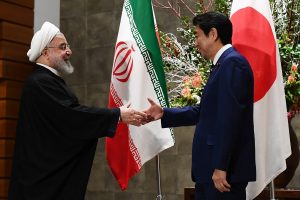General Qassem Soleimani, commander of Iran’s Islamic Revolutionary Guard Corps’ (IRGC) Quds Force, was killed on January 3 in Iraq, along with Abu Mahdi al-Muhandis, the leader of Iraq’s Pro-Iranian Shia militia Kata’ib Hezbollah. The event sparked concerns that military tensions could escalate out of control.
An Initial Miscalculation
This crisis is best regarded as an escalation that has occurred due to series of miscalculations by both Iran and the United States. Iran acted in accordance with its belief that U.S President Donald J. Trump was “a president who would not pull the trigger.” Emboldened, Iran’s Soleimani sought to take advantage of rising anti-American sentiment in Iraq, where he wielded strong influence, by attacking U.S. military stationed there. That attack took place in December, claiming the life of a U.S. military contractor. The United States tried to respond in a proportionate manner by bombing a Shia militia base.
However, the attack on a base in Iraq heightened anti-American sentiment among the Iraqi people, who then stormed the U.S. Embassy in Baghdad, changing the calculation significantly. In response, Trump made the decision to assassinate Soleimani.
That decision was also a miscalculated one. Trump had believed that killing “the bad guy” Soleimani would be applauded by Iranian dissidents, when in fact it had the potential to plunge the two nations into conflict. Millions of Iranians publicly mourned Soleimani’s death. It was a serious miscalculation for Trump ahead of the U.S. presidential elections.
Rewriting the Script
Following this mutual miscalculation, the situation escalated. Trump tweeted that if Iran retaliated, he would attack 52 locations in Iran, including cultural heritage sites.
That tweet contained several messages. First, by hinting at a major attack on Iran, it conveyed the message that any retaliatory attack by Iran could trigger a large-scale war. The aim was likely deterrence.
Second, it cites the number 52 without acknowledging the damage that would be sustained by Americans in retaliatory attacks. Evoking the image of the Iran hostage crisis in 1979, implicit in the message was the failure to acknowledge that even if Americans did not die, they would be harmed in some way.
Third, the Iran hostage crisis was a factor in then President Jimmy Carter losing the 1980 presidential election to Republican candidate Ronald Reagan. Ahead of the 2020 election, there is no doubt that Trump was keenly aware of the need to avoid making the same mistake. Hence his over-reaction in response to the attack on the U.S. Embassy in Baghdad.
Iran understood all this well, but it could not stand by and do nothing in response to the killing of Soleimani, a popular national figure. Launching missiles from within the country demonstrated to its people the state’s willingness to avenge Soleimani’s killing. However, Teheran gave the Iraqi government six hours’ notice of its intention to attack before carrying out highly targeted attacks on warehouses and other places likely to be occupied by U.S. soldiers. Moreover, Iran announced in Iran that 80 U.S. soldiers had been killed, while in fact the attack was carried out in such a way as to ensure that there was no loss of life. Trump did not retaliate, which Iran interpreted to mean that the U.S. had laid down its arms, and the risk of war has subsided, at least for now.
Abe Visits Middle East and Dispatches SDF
The immediate crisis may be over, but U.S.-Iran relations and the situation in the Middle East is far from stable. Nonetheless, on January 12, Japanese Prime Minister Shinzo Abe went ahead with his round of visits to Saudi Arabia, UAE, and Oman. Amid rising tensions in the aftermath of the killing of Soleimani, Japan had considered cancelling the visits. However, there were strong calls for them to go ahead in order for Japan to act as an intermediary amid the tensions.
The purpose of Abe’s visit to the Middle East was twofold: to explain the purpose of dispatching the Self-Defense Forces to Saudi Arabia and the UAE, which are hostile to Iran; and to set the stage for Abe to enable a peace dialogue between Saudi Arabia, the UAE, and Iran, by empathizing with the Hormuz Peace Endeavor (HOPE) proposed by Iran at the summit meeting with President Hassan Rouhani at the end of last year.
Improving relations between Iran, Saudi Arabia, and the UAE and stabilizing the situation in the Persian Gulf and Strait of Hormuz to ensure safe navigation is crucial for Japan’s energy security. If, through Abe’s round of visits to the Middle East, Japan can build on the momentum created by the subsided conflict between the U.S. and Iran to improve relations by mediating between Iran, which is promoting HOPE, and Saudi Arabia, which is pursuing economic reform, it would be an unprecedented achievement in Japan’s Middle Eastern diplomacy. The world should hope that the attempt succeeds.
Kazuto Suzuki is a professor of International Politics at the Public Policy School of Hokkaido University.
































